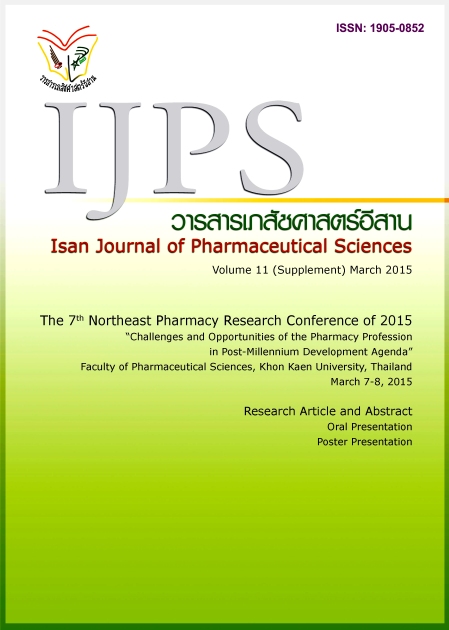Computer Program for Designing Appropriate Dosage Regimen of Vancomycin in Post Operative Congenital Heart Disease Pediatric Patients
Main Article Content
Abstract
Introduction: The problem when using vancomycin is large inter-patient and narrow therapeutic range and it has various side effects such as nephrotoxicity, ototoxicity and Red-man syndrome. Therefore, appropriate dosage regimen for individualized patient provided the most effective and less toxicity for pediatric patients. The objective of this study was to develop computer program for calculation of pharmacokinetic parameters, dosage regimen, and predicted concentrations of vancomycin in pediatric patients. Materials and Method: The program was developed from the data of 99 post operative congenital heart disease pediatric patients using Microsoft visual studio .NET 2008 and writing with C# language and the program was validated in comparison with previous study using root mean square error (RMSE) for analyzing precision. Results: For program validation, the data of 13 pediatric patients were used to calculate pharmacokinetic parameters and concentrations. RMSE of peak and trough concentrations were 3.21 mg/L and 5.59 mg/L, respectively. The error from this study was lower than previous study by Marqués-Miñana MR et al. with the RMSE of peak and trough concentrations were 7.17 mg/L and 6.68 mg/L, respectively. Conclusion: Computer program of vancomycin was successfully developed for designing appropriate dosage regimen. In addition, the use of this program easier and faster calculation than manual method. Moreover, it is very useful for pharmacist and healthcare teams in management vancomycin therapy in such patients.
Article Details
In the case that some parts are used by others The author must Confirm that obtaining permission to use some of the original authors. And must attach evidence That the permission has been included
References
Forouzesh A, Moise PA, Sakoulas G. Vancomycin Ototoxicity: a Reevaluation in an Era of Increasing Doses. Antimicrob Agents Chemother. 2009; 53(2): 483-6.
Keyserling HL, Sinkowitz-Cochran RL, Harris JM II, et al Vancomycin use in hospitalized pediatric patients. Pediatrics. 2003;112: e104-10.
Marqués-Miñana MR, Saadeddin A, Peris JE. Population pharmacokinetic analysis of vancomycin in neonate: A new proposal of initial dosage guideline. Br J Clin Pharmacol. 2010; 70(5): 713-20.
Preechagoon Y, Somsaard P. A Computer-based Pharmacokinetic Implementation for igoxin Therapeutic Monitoring in Pediatric Patients. CMU J Nat Sci. 2012; 11(1): 77-86.
Purwonugroho TA, Chulavatnatol S, Preechagoon Y, et al. Population Pharmacokinetics of Vancomycin in Thai Patients. The Scien World J. 2012: 1-8.
Sivagnanam S, Deleu D. Red man syndrome. Critical Care 2003, 7:119-20.
Shojania KG, Yokoe D, Platt R, et al. J Am Med Inform Assoc. 1998; 5: 554–62.
Teng CB, Rezai K, Itokazu GS, et al. Continuation of High-Dose Vancomycin despite Nephrotoxicity. Antimicrob. Agents Chemother. 2012, 56(6): 3470-1.
Vandecasteele SJ, De Vriese AS. Recent changes in vancomycin use in renal failure. Kidney Int. 2010; 77: 760–4.
Ye ZK, Tang HL, Zhai SD. Benefits of Therapeutic Drug Monitoring of Vancomycin: A Systematic Review and Meta-Analysis. Plos One. 2013; 8(10): 1-10.


